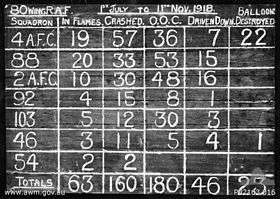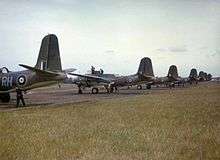No. 88 Squadron RAF
| No 88 Squadron | |
|---|---|
| Active |
24 Jun 1917- 1919 17 Jun 1937 - 1945 1 Sep 1946 – 1 Oct 1954 16 Jan 1956 – 17 Dec 1962 |
| Country |
|
| Branch |
|
| Motto(s) | French: En garde ("Be on your guard") |
| Insignia | |
| Squadron Badge heraldry | A serpent gliding.The snake is based on the 1914-18 War badge of No.88 Squadron of the French Air Service (Escadrille SPA.88) with which this squadron was associated. The compliment of adopting this badge was warmly welcomed by the French Air Service at that time.[1] |
| Squadron codes |
HY Apr 1939 - Sep 1939 RH Sep 1939 - Apr 1945 |
No 88 Squadron RAF was an aircraft squadron of the Royal Air Force. It was formed at Gosport, Hampshire in July 1917 as a Royal Flying Corps (RFC) squadron.[2]
Involvement in World War I

After forming at Gosport in July 1917, the squadron was moved to France in April 1918 where it undertook fighter-reconnaissance duties. It was also involved in the development of air-to-air wireless telegraphy. After the foundation of the Royal Air Force in June 1918, the squadron became part of No. 80 Wing RAF, which specialised in attacks on German airfields.
Despite its short service at the front, the squadron claimed 147 victories for casualties of two killed in action, five wounded in action, and ten missing. Eleven aces served in the unit, including Kenneth Burns Conn, Edgar Johnston, Allan Hepburn, Charles Findlay, and Gerald Anderson.[3] It was disbanded in 1919.
Involvement in World War II

No. 88 squadron was reformed in 1937 as a bomber squadron equipped with the Fairey Battle. The first recorded RAF "kill" of the Second World War is claimed by air observer Sergeant F Letchford aboard a Fairey Battle flown by Flying Officer LH Baker.[1]
It began the war as part of the RAF Advanced Air Striking Force, making it one of the first squadrons to be sent to France and suffered very heavy losses during the Battle of France. They returned to Britain in June 1940, moving to RAF Sydenham, Belfast where they operated a mix of Battles, Douglas Boston Is and Bristol Blenheim IVs, carrying out patrol duties over the Western Approaches.
In July 1941 the squadron moved to RAF Swanton Morley, East Anglia where it converted fully to the Boston III and IIIA. From there it carried out attacks on German coastal shipping and targets on the coast of occupied Europe.
In August 1943 the squadron relocated to RAF Hartford Bridge, Hampshire with its sister squadron No. 342 Squadron as part of 137 wing of No.2 Group of the 2nd Tactical Air Force in preparation for the invasion of Europe. From there the squadron attacked German communications and airfields. On D-Day itself it was charged with laying the smokescreen to hide the first wave of landing craft.
In October 1944 the squadron returned to France to join the tactical air forces that were supporting the Allied armies as they advanced across Europe. The squadron was finally disbanded on 4 April 1945.
Post-war History
On 1 September 1946, No. 1430 Flight at RAF Kai Tak, Hong Kong was redesignated No. 88 Squadron for transport duties with six Short Sunderland flying boats. Courier services between bases in the Far East were operated until it was redesignated a general reconnaissance unit. It was disbanded on 1 October 1954.
On 15 January 1956, No. 88 reformed at RAF Wildenrath as an interdiction squadron equipped with English Electric Canberras. On 17 December 1962, it was renumbered No. 14 Squadron RAF.
Air Training Corps
In 2014 No 88 (Battle) Squadron of the Air Training Corps was created, the Sqn being located in Battle, East Sussex, UK. The Squadron Commander selected the number 88 in memory of the Fairey Battle aircraft which the original squadron had used.
See also
References
- 1 2 http://www.raf.mod.uk/history/88squadron.cfm Ministry of Defence
- ↑ Gutman, J. "Bristol F2 Fighter Aces of World War 1". Osprey Publishing, 2007. ISBN 978-1-84603-201-1
- ↑ http://www.theaerodrome.com/services/gbritain/rfc/88.php Retrieved 20 February 2010.
External links
| Wikimedia Commons has media related to No. 88 Squadron RAF. |